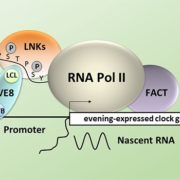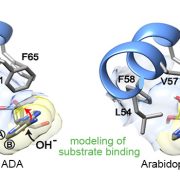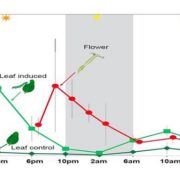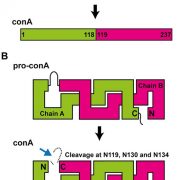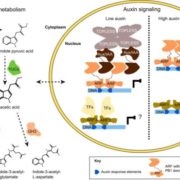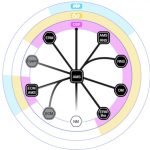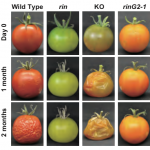Disturbance of floral color pattern by activation of an endogenous virus in aged petunia plants (Plant J)
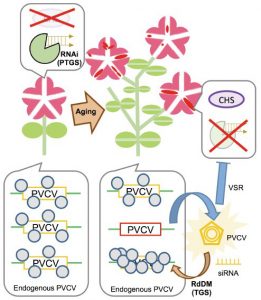 The red color of petunia petals is due to the presence of anthocyanin pigments, produced in part through the action of the chalcone synthase enzyme. In the “Red Star”’ variety, expression of the CHS-A gene encoding chalcone synthase is silenced in cells around the midvein through post-transcriptional gene silencing (PTGS). Plant viruses can inhibit naturally occurring PTGS by viral suppressors of RNA silencing (VSRs) to protect themselves. In this work, Kuriyama et al. characterized the activation process of petunia vein clearing virus (PVCV), an endogenous pararetrovirus, and the effect of its activation on the bicolor pattern of star-type petunia; they observed that in aged plants, anthocyanin accumulates in the normally white petal regions. The authors identified a decrease in DNA methylation level in the promoter region of proviral PVCV in aged petunia plants, supporting the interpretation that the virus is activated. PVCV transcripts and episomal DNA accumulation were found in regions of blotched petals, where the expression of CHS-A was also restored. This indicates PTGS suppression by VSRs activity; in other words, the gene, normally silenced by PTGS, is switched on because VSR suppresses PTGS. The appearance of blotched flowers show that in aged plants, PVCV have won the tug-of-war between a plant host and a pathogen. (Summary by Elisandra Pradella) Plant Journal 10.1111/tpj.14728
The red color of petunia petals is due to the presence of anthocyanin pigments, produced in part through the action of the chalcone synthase enzyme. In the “Red Star”’ variety, expression of the CHS-A gene encoding chalcone synthase is silenced in cells around the midvein through post-transcriptional gene silencing (PTGS). Plant viruses can inhibit naturally occurring PTGS by viral suppressors of RNA silencing (VSRs) to protect themselves. In this work, Kuriyama et al. characterized the activation process of petunia vein clearing virus (PVCV), an endogenous pararetrovirus, and the effect of its activation on the bicolor pattern of star-type petunia; they observed that in aged plants, anthocyanin accumulates in the normally white petal regions. The authors identified a decrease in DNA methylation level in the promoter region of proviral PVCV in aged petunia plants, supporting the interpretation that the virus is activated. PVCV transcripts and episomal DNA accumulation were found in regions of blotched petals, where the expression of CHS-A was also restored. This indicates PTGS suppression by VSRs activity; in other words, the gene, normally silenced by PTGS, is switched on because VSR suppresses PTGS. The appearance of blotched flowers show that in aged plants, PVCV have won the tug-of-war between a plant host and a pathogen. (Summary by Elisandra Pradella) Plant Journal 10.1111/tpj.14728
[altmetric doi=”10.1111/tpj.14728″ details=”right” float=”right”]


